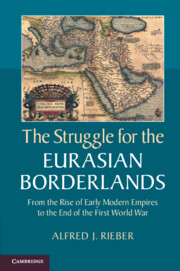 The Struggle for the Eurasian Borderlands
The Struggle for the Eurasian Borderlands Book contents
3 - Imperial institutions: armies, bureaucracies, and elites
Published online by Cambridge University Press: 05 June 2014
Summary
If the struggle over the borderlands profoundly affected state-building in the multicultural societies of Eurasia, the reverse was also true. The two processes interacted with one another not only in shaping imperial ideologies, but also in constructing political and socioeconomic institutions. Three key elements in the evolving structures of empire were the army, the bureaucracy, and the ruling elites. This chapter deals with the ways in which these institutions and groups reflected the particular needs of a multicultural state in expanding and defending its military frontiers and imposing order in the borderlands.
The exercise of power in the multicultural states of Eurasia combined in different proportions elements of what Max Weber identified as charismatic, patriarchal, and bureaucratic forms of authority. As he noted, “the majority of all great continental empires had a fairly strong patrimonial character until and even after the beginning of modern times.” But pure patriarchalism probably never existed. In its most arbitrary forms it gradually diminished without entirely disappearing under the increasing need of the ruler for a more reliable system of raising revenue and a greater functional specialization in administration. In an imperial, multicultural system the personal authority of the ruler depended heavily on his ability to project charisma through myths, symbols, rituals, and ceremonies of power that had meaning for peoples of different cultures. But charisma, as Weber and others also remind us, is unstable.
- Type
- Chapter
- Information
- The Struggle for the Eurasian BorderlandsFrom the Rise of Early Modern Empires to the End of the First World War, pp. 166 - 292Publisher: Cambridge University PressPrint publication year: 2014


